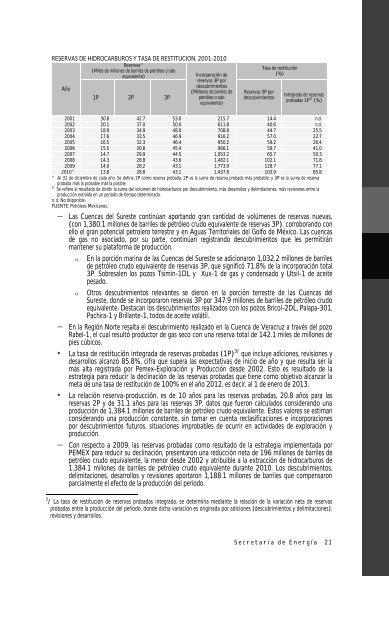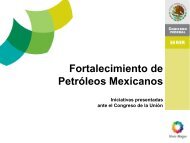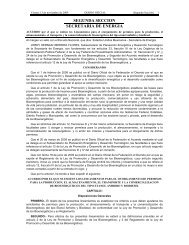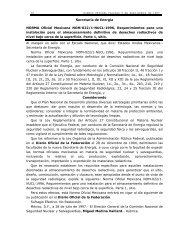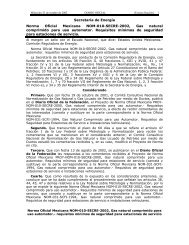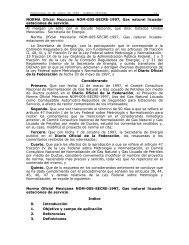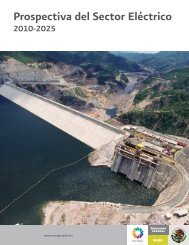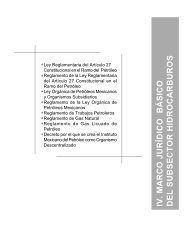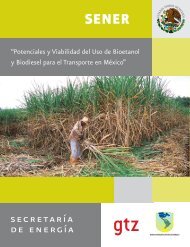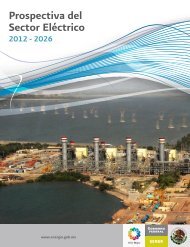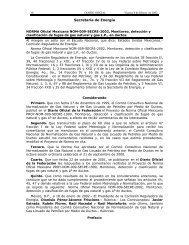Quinto Informe de Labores de la SENER - SecretarÃa de EnergÃa
Quinto Informe de Labores de la SENER - SecretarÃa de EnergÃa
Quinto Informe de Labores de la SENER - SecretarÃa de EnergÃa
You also want an ePaper? Increase the reach of your titles
YUMPU automatically turns print PDFs into web optimized ePapers that Google loves.
RESERVAS DE HIDROCARBUROS Y TASA DE RESTITUCIÓN, 2001-2010<br />
Reservas 1/<br />
(Miles <strong>de</strong> millones <strong>de</strong> barriles <strong>de</strong> petróleo crudo<br />
equivalente)<br />
Incorporación <strong>de</strong><br />
reservas 3P por<br />
<strong>de</strong>scubrimientos<br />
Año<br />
(Millones <strong>de</strong> barriles <strong>de</strong><br />
1P 2P 3P<br />
petróleo crudo<br />
equivalente)<br />
Reservas 3P por<br />
<strong>de</strong>scubrimientos<br />
Tasa <strong>de</strong> restitución<br />
(%)<br />
Integrada <strong>de</strong> reservas<br />
probadas 1P 2/ (%)<br />
2001 30.8 42.7 53.0 215.7 14.4 n.d.<br />
2002 20.1 37.0 50.0 611.8 40.6 n.d.<br />
2003 18.9 34.9 48.0 708.8 44.7 25.5<br />
2004 17.6 33.5 46.9 916.2 57.0 22.7<br />
2005 16.5 32.3 46.4 950.2 59.2 26.4<br />
2006 15.5 30.8 45.4 966.1 59.7 41.0<br />
2007 14.7 29.9 44.5 1,053.2 65.7 50.3<br />
2008 14.3 28.8 43.6 1,482.1 102.1 71.8<br />
2009 14.0 28.2 43.1 1,773.9 128.7 77.1<br />
2010 3/ 13.8 28.8 43.1 1,437.8 103.9 85.8<br />
1/ Al 31 <strong>de</strong> diciembre <strong>de</strong> cada año. Se <strong>de</strong>fine 1P como reserva probada; 2P es <strong>la</strong> suma <strong>de</strong> reserva probada más probable; y 3P es <strong>la</strong> suma <strong>de</strong> reserva<br />
probada más <strong>la</strong> probable más <strong>la</strong> posible.<br />
2/ Se refiere al resultado <strong>de</strong> dividir <strong>la</strong> suma <strong>de</strong>l volumen <strong>de</strong> hidrocarburos por <strong>de</strong>scubrimiento, más <strong>de</strong>sarrollos y <strong>de</strong>limitaciones, más revisiones entre <strong>la</strong><br />
producción extraída en un periodo <strong>de</strong> tiempo <strong>de</strong>terminado.<br />
n. d. No disponible.<br />
FUENTE: Petróleos Mexicanos.<br />
Las Cuencas <strong>de</strong>l Sureste continúan aportando gran cantidad <strong>de</strong> volúmenes <strong>de</strong> reservas nuevas,<br />
(con 1,380.1 millones <strong>de</strong> barriles <strong>de</strong> petróleo crudo equivalente <strong>de</strong> reservas 3P), corroborando con<br />
ello el gran potencial petrolero terrestre y en Aguas Territoriales <strong>de</strong>l Golfo <strong>de</strong> México. Las cuencas<br />
<strong>de</strong> gas no asociado, por su parte, continúan registrando <strong>de</strong>scubrimientos que les permitirán<br />
mantener su p<strong>la</strong>taforma <strong>de</strong> producción.<br />
<br />
En <strong>la</strong> porción marina <strong>de</strong> <strong>la</strong>s Cuencas <strong>de</strong>l Sureste se adicionaron 1,032.2 millones <strong>de</strong> barriles<br />
<strong>de</strong> petróleo crudo equivalente <strong>de</strong> reservas 3P, que significó 71.8% <strong>de</strong> <strong>la</strong> incorporación total<br />
3P. Sobresalen los pozos Tsimin-1DL y Xux-1 <strong>de</strong> gas y con<strong>de</strong>nsado y Utsil-1 <strong>de</strong> aceite<br />
pesado.<br />
Otros <strong>de</strong>scubrimientos relevantes se dieron en <strong>la</strong> porción terrestre <strong>de</strong> <strong>la</strong>s Cuencas <strong>de</strong>l<br />
Sureste, don<strong>de</strong> se incorporaron reservas 3P por 347.9 millones <strong>de</strong> barriles <strong>de</strong> petróleo crudo<br />
equivalente. Destacan los <strong>de</strong>scubrimientos realizados con los pozos Bricol-2DL, Pa<strong>la</strong>pa-301,<br />
Pachira-1 y Bril<strong>la</strong>nte-1, todos <strong>de</strong> aceite volátil.<br />
En <strong>la</strong> Región Norte resalta el <strong>de</strong>scubrimiento realizado en <strong>la</strong> Cuenca <strong>de</strong> Veracruz a través <strong>de</strong>l pozo<br />
Rabel-1, el cual resultó productor <strong>de</strong> gas seco con una reserva total <strong>de</strong> 142.1 miles <strong>de</strong> millones <strong>de</strong><br />
pies cúbicos.<br />
La tasa <strong>de</strong> restitución integrada <strong>de</strong> reservas probadas (1P) 3/ que incluye adiciones, revisiones y<br />
<strong>de</strong>sarrollos alcanzó 85.8%, cifra que supera <strong>la</strong>s expectativas <strong>de</strong> inicio <strong>de</strong> año y que resulta ser <strong>la</strong><br />
más alta registrada por Pemex-Exploración y Producción <strong>de</strong>s<strong>de</strong> 2002. Esto es resultado <strong>de</strong> <strong>la</strong><br />
estrategia para reducir <strong>la</strong> <strong>de</strong>clinación <strong>de</strong> <strong>la</strong>s reservas probadas que tiene como objetivo alcanzar <strong>la</strong><br />
meta <strong>de</strong> una tasa <strong>de</strong> restitución <strong>de</strong> 100% en el año 2012, es <strong>de</strong>cir, al 1 <strong>de</strong> enero <strong>de</strong> 2013.<br />
La re<strong>la</strong>ción reserva-producción, es <strong>de</strong> 10 años para <strong>la</strong>s reservas probadas, 20.8 años para <strong>la</strong>s<br />
reservas 2P y <strong>de</strong> 31.1 años para <strong>la</strong>s reservas 3P, datos que fueron calcu<strong>la</strong>dos consi<strong>de</strong>rando una<br />
producción <strong>de</strong> 1,384.1 millones <strong>de</strong> barriles <strong>de</strong> petróleo crudo equivalente. Estos valores se estiman<br />
consi<strong>de</strong>rando una producción constante, sin tomar en cuenta rec<strong>la</strong>sificaciones e incorporaciones<br />
por <strong>de</strong>scubrimientos futuros, situaciones improbables <strong>de</strong> ocurrir en activida<strong>de</strong>s <strong>de</strong> exploración y<br />
producción.<br />
Con respecto a 2009, <strong>la</strong>s reservas probadas como resultado <strong>de</strong> <strong>la</strong> estrategia implementada por<br />
PEMEX para reducir su <strong>de</strong>clinación, presentaron una reducción neta <strong>de</strong> 196 millones <strong>de</strong> barriles <strong>de</strong><br />
petróleo crudo equivalente, <strong>la</strong> menor <strong>de</strong>s<strong>de</strong> 2002 y atribuible a <strong>la</strong> extracción <strong>de</strong> hidrocarburos <strong>de</strong><br />
1,384.1 millones <strong>de</strong> barriles <strong>de</strong> petróleo crudo equivalente durante 2010. Los <strong>de</strong>scubrimientos,<br />
<strong>de</strong>limitaciones, <strong>de</strong>sarrollos y revisiones aportaron 1,188.1 millones <strong>de</strong> barriles que compensaron<br />
parcialmente el efecto <strong>de</strong> <strong>la</strong> producción <strong>de</strong>l periodo.<br />
3 / La tasa <strong>de</strong> restitución <strong>de</strong> reservas probadas integrada, se <strong>de</strong>termina mediante <strong>la</strong> re<strong>la</strong>ción <strong>de</strong> <strong>la</strong> variación neta <strong>de</strong> reservas<br />
probadas entre <strong>la</strong> producción <strong>de</strong>l periodo, don<strong>de</strong> dicha variación es originada por adiciones (<strong>de</strong>scubrimientos y <strong>de</strong>limitaciones),<br />
revisiones y <strong>de</strong>sarrollos.<br />
S e c r e t a r í a d e E n e r g í a 21


